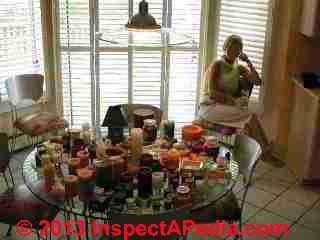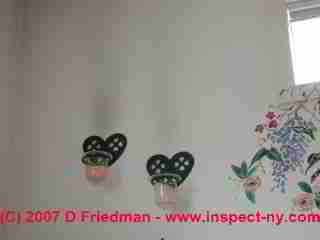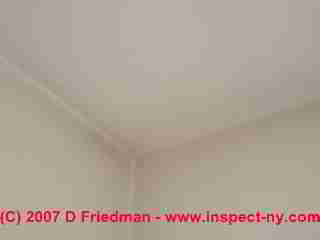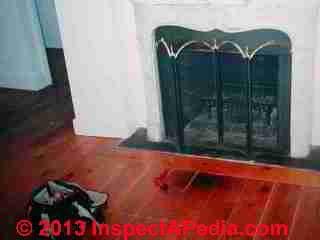 Candle or Wood Fire Soot Stains
Candle or Wood Fire Soot Stains
How to Recognize & Diagnose Indoor Stains from Candles, Woodstoves, Fireplaces. Safety warning about soot deposits indoors
- POST a QUESTION or COMMENT about how to diagnose and prevent indoor wall, ceiling or floor stains due to burning candles, woodstoves, or fireplaces
Interior wall or ceiling stains traced to candles, fireplaces, woodstoves:
This article describes & diagnoses indoor stains traced to burning candles, scented candles, fireplaces, woodstoves, kerosene lamps: common causes of dark interior wall and ceiling or floor carpet stains. We explain how to recognize these stains and the role in their creation of thermal tracking, thermal bridging, building air leaks, and building insulation defects. Often these fire or candle stains are mistaken for toxic indoor mold.
Review these causes of dark indoor stains to learn recognize non-fungal materials or even possibly harmless cosmetic "black mold" often mistaken for "toxic fungal growth." Our page top photo shows a client thinking about her collection of scented candles - a source of indoor stains and odors that can be a problem for asthmatics others.
InspectAPedia tolerates no conflicts of interest. We have no relationship with advertisers, products, or services discussed at this website.
- Daniel Friedman, Publisher/Editor/Author - See WHO ARE WE?
How to Recognize Wall or Ceiling Stains due to use of Candles, Woodstoves, or Fireplaces

Smokers or scented candle hazards
In buildings where occupants are or have been smokers, or where occupants burn candles, especially scented candles, thermal tracking will often be still more distinctly visible as soot stains in the thermal tracking patterns we've already discussed.
Since scented candles can be a source of indoor air quality problems including toxic lead deposition and perfumes which are respiratory irritants to some people, thermal tracking on buildings combined with this evidence can also be a clue useful in diagnosing indoor air quality complaints.
In these photographs, all of the stains visible appear due to use of candles. Note the absence of framing-interval staining (16" or 24" on center) which would have been characteristic of thermal tracking, even of the candle soot, had the building surfaces been cool due to poor insulation.
Also see AIR SEALING STRATEGIES
as well as AIR LEAK MINIMIZATION.
Indoor Stains from Cigarette Smoking
Stains from years of cigarette or cigar smoking appear as a yellow-brown haze on building walls, deposited much like the black and gray stains deposited from candles, fireplaces and woodstoves.
Smoking stains indoors tend to leave a bit of a sticky residue on glossy-painted surfaces. In addition, attempts to wash down stained walls or other events causing condensation on wall surfaces often leave white streaks down walls where rivulets of water descended, washing away some of the nicotine and smoke deposits.
Identify Candles, Fireplaces, Woodstoves as the Source of Indoor Stains by Pattern & Location & Use History
You can spot indoor stains to candles most easily by noticing the location of stains in relation to candles - see our photo at above right.
Similarly, fireplace smoke or soot stains indoors tend to be deposited on walls and ceilings or even the mantle and hearth face right above the fireplace (photo above).
Watch out: But what about the black stain on the wood floor in our photo above ? It's pretty obvious that the too-narrow hearth width combined with the burned flooring are strong evidence that building a fireplace without an adequate hearth can set the house on fire.
So start where the stain is most dark and look for the nearby source.
Dangerous Soot Stains Traced to Heating Equipment
Watch out: Safety warning about soot: Sooting can occur with both gas fired and oil fired systems.
- Soot coming from a gas fired heater is probably indicating a very dangerous condition risking carbon monoxide poisoning. If a gas fired appliance is producing soot, it should be turned off and Immediate service is needed.
See GAS BURNER FLAME & NOISE DEFECTS
and COMBUSTION AIR DEFECTS
and GAS FIRED WATER HEATERS for safety warnings about soot at heating appliances.
Also see CARBON MONOXIDE - CO for an explanation of potentially fatal carbon monoxide poisoning. - Soot coming from an oil fired heating appliance also indicates improper operation and risks a dangerous puffback.
See OIL BURNER SOOT & PUFFBACKS for oil fired heating equipment. Also
see SOOT on OIL FIRED HEATING EQUIPMENT.
Reader Question: What is causing black soot in my condo, who is responsible if it's the heating system, and is it dangerous?
I read an article concerning thermal tracking, ghosting, soot online. I have a major problem with that in my condo and i have a few questions that i need help with. would you mind my asking them to you, if you would answer them it would help me out quite a bit.
I live in a garden style condo that is a mess with all the soot all over my walls, windows, etc. what can i do?
I asked the plumber what can i do and he said it was my responsibility, but if this has issues concerning the heating system who would be responsible for this? there is one main boiler for the whole bldg. is this a health issue? Who can I contact about this in the mass area? Or can you help me? I am worried concerning my health more than anything else. Please any information that you can send to me would be a big help right now. - D.B.
Reply: identify the source of soot, and resolve unsafe heating system problems before beginning cleanup
A competent onsite inspection by an expert usually finds additional clues that help accurately diagnose a problem. That said, here are some things to consider:
First establish that the soot you see is due to the heating system; if the same system is serving multiple condo units in the building, as your note indicates, then in most cases one would expect other residents to have the same problem.
A basic explanation of thermal tracking or "ghosting" is provided
at THERMAL TRACKING & THERMAL BRIDGING.
Common causes of black stains on interior walls are described
at WALL THERMAL TRACKING STAINS and
at STAINS on INDOOR SURFACES, PHOTO GUIDE
Second, severe sooting traced to the boiler indicates both improper operation and possibly very unsafe conditions at the boiler, especially if it's a gas unit (carbon monoxide hazards); Be sure you have working smoke detectors and CO detectors in your home.
Now if sooting is traced to the heater, then you may have a claim for cleaning and restoration work to remove the soot from your own home, as one would expect it is due to improper system maintenance, or repair.
That's something to discuss with your condo owners association and management association, not the local plumber or heating contractor. But this concern, while understandably troubling to you, should be addressed after any questions about current operating safety of the system have been addressed.
See OIL BURNER SOOT & PUFFBACKS
and OIL BURNER NOISE SMOKE ODORS
or if your system is a gas fired heater see
GAS BURNER Flame & Noise Defects and
Soot can indeed be a respiratory or eye irritant if at high levels.
If you have extensive soot damage that will require professional cleaning, and perhaps re-painting, you should also contact your homeowner's insurance company. Soot cleanup may involve washing and re-painting walls and ceilings, professional carpet cleaning, and cleaning, laundering, or dry cleaning of curtains etc. But I wouldn't begin cleanup before the cause of the sooting is identified and cured.
...
Continue reading at THERMAL TRACKING BRIDGING GHOSTING - home, or select a topic from the closely-related articles below, or see the complete ARTICLE INDEX.
Or see these
Recommended Articles
- IAQ DIAGNOSIS via THERMAL TRACKING STAINS
- OIL BURNER SOOT & PUFFBACKS
- STAIN DIAGNOSIS on BUILDING INTERIORS - home
- STAINS on INDOOR SURFACES, PHOTO GUIDE
- THERMAL TRACKING BRIDGING GHOSTING - home
Suggested citation for this web page
STAINS CANDLES FIREPLACE WOODSTOVE at InspectApedia.com - online encyclopedia of building & environmental inspection, testing, diagnosis, repair, & problem prevention advice.
Or see this
INDEX to RELATED ARTICLES: ARTICLE INDEX to BUILDING STAINS
Or use the SEARCH BOX found below to Ask a Question or Search InspectApedia
Ask a Question or Search InspectApedia
Questions & answers or comments about how to diagnose and prevent indoor wall, ceiling or floor stains due to burning candles, woodstoves, or fireplaces.
Try the search box just below, or if you prefer, post a question or comment in the Comments box below and we will respond promptly.
Search the InspectApedia website
Note: appearance of your Comment below may be delayed: if your comment contains an image, photograph, web link, or text that looks to the software as if it might be a web link, your posting will appear after it has been approved by a moderator. Apologies for the delay.
Only one image can be added per comment but you can post as many comments, and therefore images, as you like.
You will not receive a notification when a response to your question has been posted.
Please bookmark this page to make it easy for you to check back for our response.
Our Comment Box is provided by Countable Web Productions countable.ca
Citations & References
In addition to any citations in the article above, a full list is available on request.
- In addition to citations & references found in this article, see the research citations given at the end of the related articles found at our suggested
CONTINUE READING or RECOMMENDED ARTICLES.
- Carson, Dunlop & Associates Ltd., 120 Carlton Street Suite 407, Toronto ON M5A 4K2. Tel: (416) 964-9415 1-800-268-7070 Email: info@carsondunlop.com. Alan Carson is a past president of ASHI, the American Society of Home Inspectors.
Thanks to Alan Carson and Bob Dunlop, for permission for InspectAPedia to use text excerpts from The HOME REFERENCE BOOK - the Encyclopedia of Homes and to use illustrations from The ILLUSTRATED HOME .
Carson Dunlop Associates provides extensive home inspection education and report writing material. In gratitude we provide links to tsome Carson Dunlop Associates products and services.




